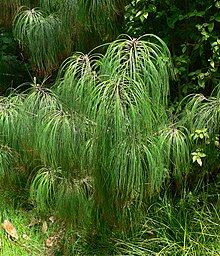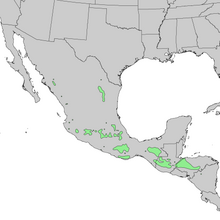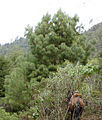Pinus pseudostrobus: Difference between revisions
OddishAzul (talk | contribs) No edit summary |
OddishAzul (talk | contribs) No edit summary |
||
| Line 46: | Line 46: | ||
A stand of about 15 fully mature smooth-bark Mexican pines is in [[Imperial County, California]], at the Palo Verde County Park, in a narrow strip of land between Hwy 78 and the [[Colorado River]]. {{citation needed|date=April 2021}} |
A stand of about 15 fully mature smooth-bark Mexican pines is in [[Imperial County, California]], at the Palo Verde County Park, in a narrow strip of land between Hwy 78 and the [[Colorado River]]. {{citation needed|date=April 2021}} |
||
English botanist [[John Lindley]] described the species in 1839. It is divided into ''Pinus pseudostrobus'' var.''apulcensis'' ([[John Lindley|Lindl.]])Shaw (Alpuco pine), ''Pinus pseudostrobus'' f.''protuberans'' |
English botanist [[John Lindley]] described the species in 1839. It is divided into ''Pinus pseudostrobus'' var.''apulcensis'' ([[John Lindley|Lindl.]])Shaw (Alpuco pine), ''Pinus pseudostrobus'' f.''protuberans'' Martínez and ''Pinus pseudostrobus'' var.''pseudostrobus''.<ref name="Plants of the World Online"/><ref name="iNaturalist"/> |
||
It has been introduced in [[New Zealand]] near sea level and has done well.{{citation needed|date=April 2021}} |
It has been introduced in [[New Zealand]] near sea level and has done well.{{citation needed|date=April 2021}} |
||
Revision as of 01:29, 13 April 2022
| Pinus pseudostrobus | |
|---|---|

| |
| var. apulcensis in cultivation | |
| Scientific classification | |
| Kingdom: | Plantae |
| Clade: | Tracheophytes |
| Clade: | Gymnospermae |
| Division: | Pinophyta |
| Class: | Pinopsida |
| Order: | Pinales |
| Family: | Pinaceae |
| Genus: | Pinus |
| Subgenus: | P. subg. Pinus |
| Section: | P. sect. Trifoliae |
| Subsection: | P. subsect. Ponderosae |
| Species: | P. pseudostrobus
|
| Binomial name | |
| Pinus pseudostrobus | |

| |
| Natural range of Pinus pseudostrobus. Pinus pseudostrobus is also found in El Salvador.[2] | |
| Synonyms | |
|
Pinus astecaensis Roezl ex Gordon[4] Pinus coatepecensis (Martínez)Gaussen[3] Pinus estevezii (Martínez) J.P.Perry[3] Pinus oaxana Mirov [4] | |
Pinus pseudostrobus, known in English as the smooth-bark Mexican pine and in Spanish as chamite or pacingo, is a tree found in forests of Mexico and Central America.[1][2][6] [citation needed] It is 8 to 25 m tall with a dense and round top.[citation needed]It is threatened by logging and wood harvesting.[1] The bark is brown and fissured and smooth when young. [citation needed] It is subject to ex-situ conservation.[1] It grows at altitudes between 850 and 3250 m. from 26° to 15° north latitude, from Sinaloa, Mexico to Nicaragua and Honduras. It occurs within a rainfall regime that rains mostly in summer. [citation needed]
A stand of about 15 fully mature smooth-bark Mexican pines is in Imperial County, California, at the Palo Verde County Park, in a narrow strip of land between Hwy 78 and the Colorado River. [citation needed]
English botanist John Lindley described the species in 1839. It is divided into Pinus pseudostrobus var.apulcensis (Lindl.)Shaw (Alpuco pine), Pinus pseudostrobus f.protuberans Martínez and Pinus pseudostrobus var.pseudostrobus.[2][6]
It has been introduced in New Zealand near sea level and has done well.[citation needed]
-
Male cones at San Francisco Botanical Garden
-
Pinus pseudostrobus, Cerro Pelón, Mexico
References
- ^ a b c d Farjon, A. (2013). "Pinus pseudostrobus". IUCN Red List of Threatened Species. 2013: e.T42404A2977667. doi:10.2305/IUCN.UK.2013-1.RLTS.T42404A2977667.en. Retrieved 16 November 2021.
- ^ a b c "Pinus pseudostrobus". Plants of the World Online. Retrieved 31 March 2021.
- ^ a b c d e f g h "Pinus pseudostrobus var.pseudostrobus". Plants of the World Online. Retrieved 2 April 2021.
- ^ a b c "Pinus pseudostrobus var.apulcensis". Plants of the World Online. Retrieved 2 April 2021.
- ^ "Pinus pseudostrobus f.protuberans". Plants of the World Online. Retrieved 4 April 2021.
- ^ a b "Pinus pseudostrobus". iNaturalist. Retrieved 31 March 2021.



